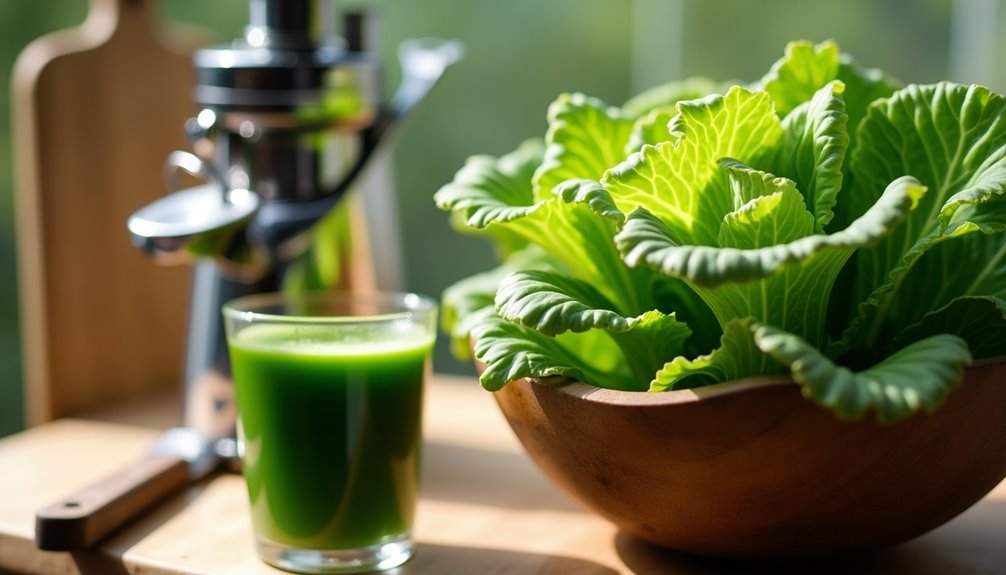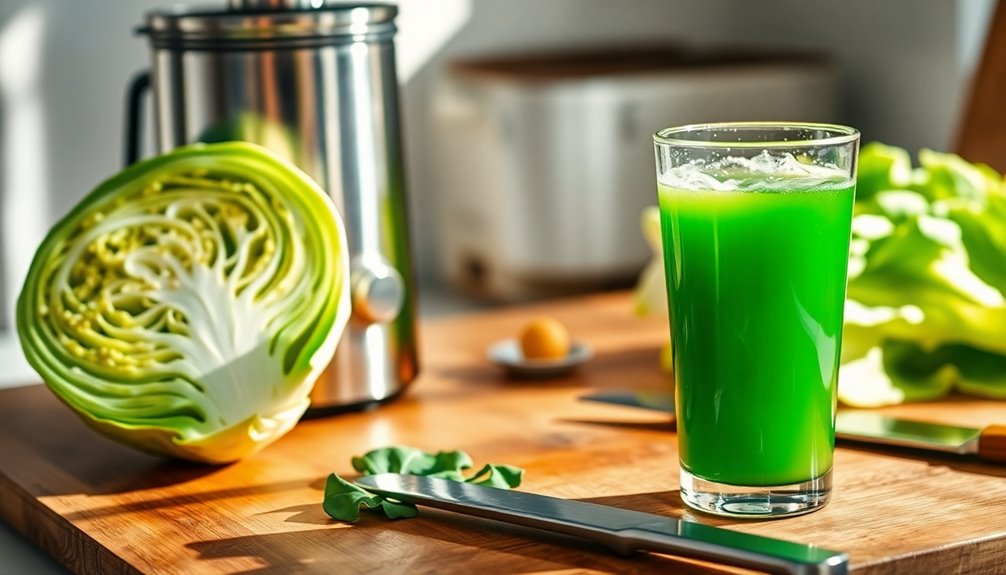To make cabbage juice, chop one head of cabbage into 1-inch pieces. You can add chopped celery, carrots, apples, or cucumbers for extra flavor and nutrients. Toss in ginger or mint for a refreshing twist. Blend everything with a bit of water for about 1-2 minutes, or use a juicer for a concentrated juice. Strain to separate the liquid from the pulp, and enjoy right away to maximize health benefits. There's plenty more to discover about cabbage juice!
Key Takeaways
- Chop one head of cabbage into 1-inch pieces, and consider adding celery, carrots, apples, or cucumbers for extra nutrients and sweetness.
- Blend the chopped ingredients with a dash of water for 1-2 minutes, or use a juicer for a more concentrated juice.
- Strain the mixture through a strainer or mesh bag to separate the juice from the pulp, capturing the liquid while discarding the fibrous parts.
- Consume the juice immediately for maximum health benefits; if storing, keep it in an airtight container in the fridge for 1-3 days.
- Experiment with flavors by adding ginger, mint, or even fermenting the juice for additional health properties.

If you’re looking to boost your health with a nutritious drink, making cabbage juice is a simple and rewarding choice. Cabbage juice is packed with vitamins and minerals that can enhance your well-being, and it’s particularly noted for its potential benefits in healing ulcers. You’ll find that preparing this juice is straightforward and can be done in just a few steps. To make cabbage juice, simply blend fresh cabbage leaves with water and strain the mixture to achieve a smooth consistency. This vibrant juice not only tastes refreshing but also offers various health benefits, including how cabbage juice helps acid reflux by soothing the stomach lining and reducing inflammation. Incorporating this drink into your daily routine can be a delicious way to support your digestive health and overall vitality.
To make your cabbage juice, start by chopping up one head of cabbage into 1-inch pieces. This will help your blender or juicer process the cabbage more efficiently. You can also add other ingredients to enhance the flavor and health benefits of your juice. Consider including chopped celery and carrots for added nutrients, or even fruits like apples and cucumbers for a touch of sweetness. You might also want to throw in some ginger or mint for an invigorating flavor twist.
Once your ingredients are prepped, it's time to blend. If you're using a blender, add a dash of water to help create a smoother consistency. Blend the mixture for about 1-2 minutes until it reaches your desired texture. If you prefer a more concentrated juice, using a juicer can simplify the process. Whichever method you choose, you'll need to strain the mixture to separate the juice from the pulp. This can be done by pouring the blended contents through a strainer or a mesh bag. The goal is to capture the liquid while leaving the fibrous pulp behind.
Fresh cabbage juice is best consumed immediately to maximize its health benefits. However, if you need to store it, you can keep it in an airtight container in the fridge for up to 1-3 days. Just remember, the longer it sits, the more it may lose its nutritional value. Ideally, you want to drink 8 oz. of freshly prepared cabbage juice one to four times daily if you're looking to reap its ulcer-healing effects. Studies suggest that consistent consumption can aid in healing ulcers within approximately nine days.
Cabbage juice isn't only nutritious but also a versatile addition to your diet. You can experiment with different ingredients based on your preferences and what you have on hand. The fermentation process can also be explored if you're interested in probiotic benefits; fermenting cabbage juice can enhance its health properties even further.
Frequently Asked Questions
How to Make Juice of Cabbage?
To make juice from cabbage, start by rinsing and chopping a head of cabbage into 1-inch pieces.
You can add other ingredients like celery or carrots for flavor.
Blend the chopped ingredients for 1-2 minutes, adding a little water if needed.
If you're using a blender, strain the mixture through a mesh bag to separate the juice from the pulp.
Serve the juice right away for the best health benefits!
How Do You Make Cabbage Juice Without a Juicer?
You'd think making cabbage juice without a juicer would be a messy disaster, but it's surprisingly simple!
First, wash and chop your cabbage into 1-inch pieces. Blend it with a bit of filtered water until smooth.
Next, strain the mixture through a nut milk bag to separate the juice from the pulp, squeezing out every drop.
Want to spice it up? Toss in some carrots or apples for extra flavor!
Can You Juice Cabbage Raw?
Yes, you can juice cabbage raw! When you do, it retains all its nutrients and enzymes, making it a healthy choice.
Raw cabbage juice is known for its healing properties, especially for ulcers, so drinking 8 oz. a few times daily can be beneficial.
Just remember to consume it right after juicing for the best freshness, or refrigerate it for up to three days if you need to store it.
Enjoy those health benefits!
Is Eating Cabbage the Same as Drinking Cabbage Juice?
No, eating cabbage isn't the same as drinking cabbage juice.
While both options provide nutrients, cabbage juice offers a more concentrated dose of vitamins and minerals without the fiber bulk. You'll absorb its nutrients more quickly in liquid form.
Eating cabbage, on the other hand, gives you dietary fiber, which aids digestion.
Conclusion
So there you have it! You've successfully transformed that humble cabbage into a juice that's not just a vibrant green but also a potential conversation starter at your next dinner party. Who wouldn't want to sip on something that resembles a science experiment gone right? Just remember, the next time someone asks for a refreshing drink, you can proudly offer them your cabbage concoction and enjoy the bewildered looks. Cheers to your newfound status as the cabbage juice connoisseur!
Cindy thoroughly researches juicing trends, techniques, and recipes to provide readers with practical advice and inspiration. Her writing style is accessible, engaging, and designed to make complex concepts easy to understand. Cindy’s dedication to promoting the advantages of juicing shines through her work, empowering readers to make positive changes in their lives through the simple act of juicing.











